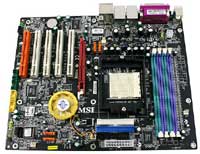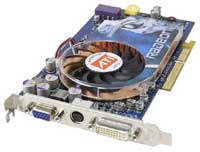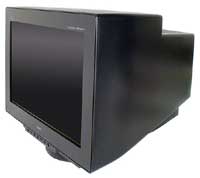High-End Gaming System
We've covered the Mid-Range and Budget sectors, so all that is left is the High-End. While there is a lot of competition in the other sectors, there really are not that many options on the bleeding edge. If money is no object - and it shouldn't be if you're thinking of spending a couple of months' rent on a game system - you can go out and buy the best parts that are available. That is in essence what we have in our High-End rig. However, we really don't recommend that anyone actually spend this much money on a gaming system. A better plan would be to pick out a few of the items that you think are the most worthwhile and stick with the Mid-Range configuration for the remainder of the system.
| High-End AMD Athlon 64 System |
| Hardware |
Recommended Component |
Price |
| Processor |
AMD Athlon 64 FX-55 1MB 2.6 GHz (939) |
877 |
| Motherboard |
MSI K8N Neo2 Platinum |
131 |
| Memory |
2x512MB Crucial Ballistix 2-2-2 1T |
262 |
| Video Card |
Sapphire X800 XT 256 MB GDDR3 AGP |
461 |
| Hard Drive |
Western Digital Raptor 74GB SATA 10000RPM 8MB Model WD740GD |
173 |
| Hard Drive |
Maxtor 300GB SATA 7200RPM 16MB Model 6B300S0 |
207 |
| Optical Drive |
NEC DVD+/-RW Drive Model 3500A |
72 |
| 2nd Optical Drive |
Lite-On 16X DVD-ROM Model SOHD-167T |
30 |
| Sound Card |
Creative Labs Audigy 2 ZS |
75 |
| Case |
Antec Lanboy Aluminum |
88 |
| Power Supply |
Antec True480 480W PSU with Blue LED |
95 |
| Display |
NEC/Mitsubishi FP2141SB-BK 22 |
634 |
| Speakers |
Logitech Z-680 5.1 THX Certified |
236 |
| Keyboard |
Logitech Internet Keyboard |
17 |
| Mouse |
Microsoft IntelliMouse Optical |
24 |
| Bottom Line |
|
3382 |

Click to enlarge. |
The choice of parts in some areas is not all that different from the Mid-Range configuration. Our motherboard recommendation remains with the MSI K8N Neo2 Platinum; even more so than the Mid-Range sector
If you are actually thinking about spending this much money on a computer, waiting for PCI Express motherboards with SLI support would really make sense. In that case, you could go with a 6800GT card now and upgrade your gaming performance with a second 6800GT when you need more performance. We expect the SLI-capable motherboards to begin appearing at retail within the next month. Until we actually see the parts on sale, we will not be listing them as an actual recommendation.
We also continue to go with the same NEC DVD burner as well as the keyboard and mouse. Some people really prefer wireless input devices, but for gaming, we personally continue to prefer wired variants. As before, go with what you're most comfortable using. The other components are all upgraded, but we are reaching the point of diminishing returns. The total system cost is roughly twice that of the Mid-Range system, and yet performance is, at best, maybe 25% faster. Let's look at the specifics.
We start with what is the fastest current processor, the AMD Athlon FX-55. Running at 2.6 GHz and with strained silicon, our initial results have shown it to be faster than any other CPU in games, and those looking for even more performance can try their hand at overclocking it. For the RAM, we have upgraded to some high quality, low latency Crucial Ballistix. With 2-2-2 timings at 200 MHz and low timings all the way up to its maximum clock speed of around 270 MHz, the Crucial RAM performs very well. Any memory that uses the latest Samsung TCCD chips is also worth consideration, and it can usually reach even higher clock speeds. OCZ PC3200 Platinum Rev. 2 is one such example, and we use the Samsung TCCD DIMMs as our standard RAM for testing. If you don't plan on overclocking, however, there's really little to differentiate one set of 2-2-2 timing RAM from another.

Click to enlarge. |
For the graphics card, we have selected ATI's X800 XT chip. The X800 XT Platinum Edition and 6800 Ultra are also possibilities for those who simply must have the best. The X800 XT strikes a nice balance between price and performance, as it outperforms the 6800GT in most games that don't have Doom 3 in the title and it costs $75 less than the slightly faster chips. Sapphire wins this category as the least expensive X800 XT card. For hardcore Doom 3 players, the NVIDIA cards remain the better choice, and if you're interested in SLI, there are two important things to remember. First, of course, is that you need to wait for PCI Express motherboards to become available, which may be a month or two out - we're sure that NVIDIA's partners are trying desperately to get the boards to market before Christmas. The other critical factor is that you will need to "downgrade" to a 6800GT. As the 6800 Ultra is a two-slot design, there will not be room to put two 6800 Ultras in a system - at least, not on the boards that we've seen. Two 6800GT cards are significantly faster than a single 6800 Ultra, though, so the tradeoff is worth it in our book.
Our hard drive selection may be overkill, but we have paired the fastest SATA hard drive available - the Western Digital Raptor - with a fast, but spacious, Maxtor DiamondMax 10 (a.k.a. Maxline-III) drive. The Maxtor drives are so new that we really don't have much data in terms of reliability, so if you have any personal experience with the drives, we'd like to hear from you. On the optical side of things, we have added a standard DVD-ROM drive to the burner, allowing for DVD to DVD copying - or CD to CD copying - if you need it. The speakers are Logitech's Z-680 5.1, which provide great sound at a reasonably affordable price. They compare favorably with Klipsch ProMedia Ultra 5.1 speakers and cost significantly less. We have also thrown in a sound card for good measure - the Creative Audigy 2 ZS is designed with gaming in mind and provides better quality than most integrated solutions as well as slightly better performance.

Click to enlarge. |
Finally, we wrap things up with the case and monitor selections. For the case, we have selected the Antec Super Lanboy paired with an Antec True480 power supply. It is very similar to the SLK3700-BQE in design, but uses an aluminum body instead of steel and has a case window on the side. Two 120 mm fans are included, and it also comes with a carrying harness that can come in handy if you're the type to haul your computer to LAN parties. Lian Li and Silverstone also make some very nice cases if you're willing to spend more money. The majority of high-end cases lack a power supply, so we used an Antec True480 480W PSU. The Antec NeoPower 480 and Ultra X Connect are also alternatives worth considering - they are 480W and 500W respectively, and they have detachable power rails so that you can avoid cluttering up the insides of your case with unused cables.

Click to enlarge. |
Our choice of display is a large 22" (20.0" viewable) NEC monitor. Providing high refresh rates (85 Hz) at even 2048x1536 as well as the ability to run at other resolutions without interpolation - the Achilles heel of LCDs - we still prefer a large CRT to LCDs for games. It also comes with four USB ports, if that sort of thing interests you. There are other 22" NEC CRTs that cost less, but if you want a huge monitor for gaming, you'll want one that supports 2048x1536, as few games support the less common resolutions such as 1920x1440. The drawback for such a CRT is that it is large and heavy, making it less than ideal for transportation to LAN parties.

Click to enlarge. |
If portability is your style, we recommend a good quality 19" LCD instead. Unlike CRTs, an LCD's viewable area is the same as their screen size, so a 19" LCD is really only slightly smaller than a 21/22" CRT (which both have a 20.0" viewable area). Low response times are the most important aspect of LCDs that will be used in gaming, and for this, we recommend the ViewSonic VP912B 19" LCD. With a 12 ms response time, there is virtually no ghosting. It does cost more, but it works great. The native resolution is 1280x1024, but we have not yet encountered any 19" LCDs that support 1600x1200 with a 12 ms response time. Besides, 1280x1024 is not quite as demanding of the GPU as 1600x1200 - if your LCD runs at a native 1600x1200 resolution, you'll need to either lower the resolution when game complexity increases or else, you'll need to upgrade your GPU more often. Neither one is very appealing. Remember also that you want a DVI-D connection on any LCD; otherwise, you're still stuck with an analog signal that can affect image quality, particularly at high resolutions.















70 Comments
View All Comments
SDA - Wednesday, December 1, 2004 - link
Whoops, I'd forgotten all about this thread.400W is fine if that's what you want, since it's your system. I wouldn't recommend to others that they spend much more for a 400W PSU (as opposed to spending more to get a higher-quality 350W or 380W PSU) when the average high-end Athlon 64 rig consumes 230W or so under load, though. I'd define 50% more than is necessary under full load "moderate," how about you?
520W is still overkill for SLI 6800GTs on an A64, although not as bad as 400W is overkill for the average A64. As I recall, SLI 6800Us on a high-end A64 eat something like 350W of power (decked out with HDDs and fans and whatnot, of course). 470W is perfectly fine there (although I'd personally just get a Tagan 480W, which should be the same and cheaper + less gaudy to boot). Again, you're welcome to do what you want, but you have an obligation to research system power consumption before you make recommendations to others.
As for E-Power/Tagan, the amperages really aren't very different. Furthermore, just because they don't look the same doesn't mean they're not. They use very similar components, have an identical layout, and use the same PCB. Trust me, PCB and components say a lot more than paint job ;) Googling Tagan and PowerStream should give you some nice solid evidence (and juicy internals pics!).
Again, nothing against the guide in general.. I just ask that you research the subject more in the future.
JarredWalton - Friday, November 26, 2004 - link
"Moderate PSU" in my book means >=400W these days. If a 350W generic PSU isn't sufficient, are you really going to want to spend $25 to $30 (shipped) for something that is the same wattage but more reliable? Maybe, but I wouldn't. If I buy an add-in PSU, I'll get at least a 400W.520W *is* overkill for most systems, but if you look at what I said it makes sense. If you want SLI with two 6800 GT or 6800 Ultra cards, you're probably going to have two (or more) hard drives and a lot of other stuff as well. I would spend the extra money for the 520W in that case. Regarding the OCZ = Tagan comment, I would have to see some really concrete evidence of that. Judging by The Egg, they're not the same:
http://www.newegg.com/app/viewProductDesc.asp?desc...
http://www.newegg.com/app/viewproductdesc.asp?desc...
The E-Power/Tagan has very different amperages than the OCZ. The shells are also different. Both are quality power supplies, of course, but even if they share some common components, that doesn't make them "the same."
Anyway, the PSU comments are duly noted and I will make sure to mention this item more clearly in the future. Please move on from the PSU comments now... nothing to see here. ;) (If you really want to comment more on the PSUs, you can. I'm only kidding people.)
SDA - Wednesday, November 24, 2004 - link
First thing to say: I don't want to sound insulting or condescending in any way. I think this is a good guide, and it's a lot of work to get a guide that a lot of people agree on as being good-- especially one as extensive as this.Now then. No, a good PSU will NOT add $50+ to the total for the budget systems. Fortron/Sparkle and TTGI power supplies are known to be solid units, if not amazing, and ones of appropriate wattage (300-350 is fine for a PC like the budget box) can be obtained for a reasonable $20-25 new. Is paying an extra 2.5~3% to avoid seeing a cheap POS PSU fail in an amusing fashion (possibly taking parts with it, I saw a Powmax unit take out an XP and mobo) and/or avoid instability worth it? Well, sure, I think so. Would you be willing to save $20 and go with cheap generic memory? Didn't think so.
And yeah, I realize the budget systems aren't meant for overclocking. That doesn't matter. I've been to the AMD official processor support forums too, and I've also worked as a tech support (paid and all, although FWIW a lot of the people that help out on those forums know what they're talking about more than pro tech supports), and I can say for certain that the biggest problem with DIY systems is cheap power supplies. They can be problematic even at stock clock speeds, and it's certainly not as if the budget systems are little old P2s that'll barely eat any power at all.
I'd also like to add, for the sake of balance, that 520W is overkill. Quality > quantity; you don't need a 450W PSU to achieve stability, not even if you're running an insane system. Oh yeah, and OCZ PowerStreams are the same as Tagans, and you can get those for pretty cheap (480W Tagan = ~$80 at the Egg of New).
JarredWalton - Wednesday, November 24, 2004 - link
54: The OCZ PowerStream is undoubtedly a good PSU, particularly for overclocking. That wasn't a primary concern with this Guide, so I didn't mention it as we have repeated that recommendation quite a few times. It's about $140 which is quite a lot for a power supply. On the other hand, for those seriously considering SLI with 6800 GT or Ultra cards, a power supply of that quality would be almost required.PseudoKnight - Wednesday, November 24, 2004 - link
Jarred, try the Logitech MX310. It has the Button4 and 5 on opposite sides like you prefer. (as I do, that's why I got one)Precise - Wednesday, November 24, 2004 - link
In your Oct. 1st Athlon 64 Memory: Rewriting the Rules review Wesley Fink stated:"We found that replacing a well-respected 465 watt PS with a 520 watt PowerStream allowed even higher memory overclocks. This was true with both the power-hungry nVidia 6800 Ultra as well as the more mainstream ATI 9800 PRO. If top memory overclocks on the Athlon 64 is your goal, don't skimp on the power supply. Putting the best PS that you can find in your system will pay off in higher memory overclocks with greater stability"
So if you want the fastest memory/system with overclocking you should get a 520 watt PS per Wesley Fink's own recommendation and review.
Glassmaster - Wednesday, November 24, 2004 - link
"Part of the problem, of course, is that many generic PSUs might work well for a couple months and then fail, and that's something that is nearly impossible to test."That might be a good reason not to recommend them :P. Keep up the good work, I would look forward to a PSU roundup.
Glassmaster.
JarredWalton - Wednesday, November 24, 2004 - link
blckgrffn - It's $40 now, it looks like, and despite the name "Silent Power" the dual 80mm fans are not at all silent. The Polo12 is quieter, but it's also about $30 more. $40 for the 420W Thermaltake isn't too bad, though.As for a PSU roundup, I would have to do a lot more research into that subject before actually doing something like that. There are probably people better qualified to do a PSU roundup than me, of course, but it is an interesting topic. I may run that by some of the others to see if they have any thoughts on the topic. Part of the problem, of course, is that many generic PSUs might work well for a couple months and then fail, and that's something that is nearly impossible to test.
Glassmaster - Tuesday, November 23, 2004 - link
Jarred:Thanks for the response. I make a big deal about it because the weak PSU thing is something that lots of people don't know about that ought to be better publicized. Perhaps a future article could be devoted to this topic?
Glassmaster.
blckgrffn - Tuesday, November 23, 2004 - link
Sigh. And I have personally used 3 and really like them. Man, got to keep myself from hitting the "Post Comment" button for at least five seconds after I think that I am done typing...